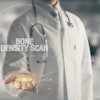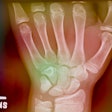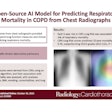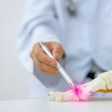CHICAGO -- German researchers are testing ways to support nonradiologists in interpreting chest x-rays in emergency settings using an AI assistant.
Presenting the research on November 28 at RSNA 2023, Jan Rudolph, MD, from the department of radiology at University Hospital LMU Munich said nonradiologists can significantly benefit from AI assistance in emergency-related chest x-ray analysis.
“If you go to the periphery, to smaller hospitals in the periphery, there's basically the duty doctors from internal medicine or surgery departments that have to analyze the chest x-rays,” Rudolph explained. “So we were thinking and asking ourselves, ‘can nonradiologists benefit from AI and chest radiography analysis in this emergency unit set.’ ”
Per year, LMU receives between 5,000 and 6,000 orders for chest radiographs for primary diagnosis from the emergency unit alone. Because the need for radiology reads also radiates away from the LMU hub in Munich, there may be a lack of radiology coverage at smaller hospitals in neighboring areas, according to Rudolph.
To test the AI algorithm, the LMU team focused on 563 cases, all ordered by the emergency unit department. The study employed a two-step reading process: first a team of nine residents read the scans, then they added the AI assist.
The team consisted of three board-certified radiologists who served as the reference standard, three radiology residents, and three internal medicine and surgery residents who had emergency unit experience at the time of the reading. For the study, radiology residents’ and nonradiology residents’ performances were statistically compared with the AI system. Cohort characteristics included pathology prevalence that was suspected pleural effusion, pneumonia, pneumothorax, and lesions.
For each of these conditions, the team concluded that the AI could serve as a clinical support tool in an emergency room setting where radiology coverage is either not available or patients are waiting due to long reporting times.
Rudolph highlighted results for pneumothorax detection, in particular, where the AI assist performed similarly to the radiology resident readers. AUCs for radiology resident readers reported were as follows:
| AUCs for radiology residents compared to nonradiology resident for pneumothorax detection on chest x-rays | ||
|---|---|---|
| Type of reader | Reader alone | Reader plus AI |
| Radiology residents | 0.97 | 0.99 |
| Nonradiology residents | 0.78 | 0.9 |
He also noted that the AI algorithm outperformed all the other readers for nodular detection, with an AUC of 0.938 compared to an AUC of 0.797 for radiology residents and an AUC of 0.613 for the nonradiology residents.




















